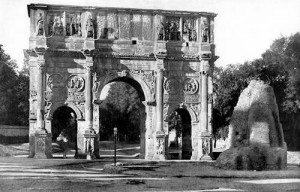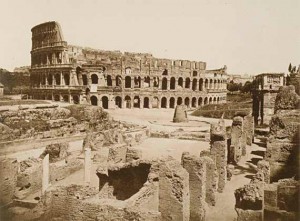Quite by accident I have stumbled across an old guide-book on Google books. It was published in 1843 by John Murray, and is full of interesting details on how to travel in these now vanished lands. On page 8 there are details of arrangements for carriage travel, and then something on inns, concluding with some very wise words:
In cases of this kind it would be absurd to carry English habits and prejudices so far as to expect the comforts and conveniences of the great cities. Travellers never gain anything by exacting or requiring more than the people can supply and if they have sufficient philosophy to keep their temper they will generally find that they are treated with civility and kindness.
That advice still holds, in hotels in places like Egypt.
The arrival in Rome on p.247 descends into details of inns and rental arrangements, all clearly the product of much experience.
The ordinary currency of Rome is the “paul”, which ran at about 50 pauls to the pound sterling of those undepreciated days. How much is that, one wonders? The National Archives calculator reckons that a pound in those days is equivalent to 50 GBP ($75) today, which would make the “paul” about the same as a modern pound, or $1.50. The numbers do “feel” roughly right, although probably a little on the low side. But such conversions are really valueless, and the reader must assess comparative value for himself.
On p.254 we get a survey of Rome, which includes this:
To the south and east of this district are the Palatine, the Aventine, the Esquiline and the Caelian, all of which, though included within the modem walls, are little better than a desert; their irregular surface is covered with vineyards or the gardens of uninhabited villas and they present no signs of human habitations but a few scattered and solitary convents.
It is different today, of course.
Another difference may be found on p.297.
Close to the Coliseum is the ruin the conical fountain called the Meta Sudans, which formed an important appendage of the amphitheatre. It appears to have been a simple jet issuing from a cone placed in the centre of brick basin, 80 feet in diameter. It was rebuilt by Domitian and is supposed to have been intended for the use of the gladiators after the labours of the arena. It is represented on several medals of the amphitheatre of the time of Vespasian, Titus, Severus &c. The fountain was constructed of brick work in the best style; the central cavity and the channels for carrying off the water are still visible. It was repaired a few years since, but these modern restorations may easily be distinguished from the ancient work.
Sadly the remaining concrete core of the meta sudans was demolished by Mussolini in 1936. A photograph from 1922 must be one of the last:
This one from the 1880′s gives an excellent impression of the fountain, and its surrounding basin:
There are many images of the meta sudans to be found in Google Images.

